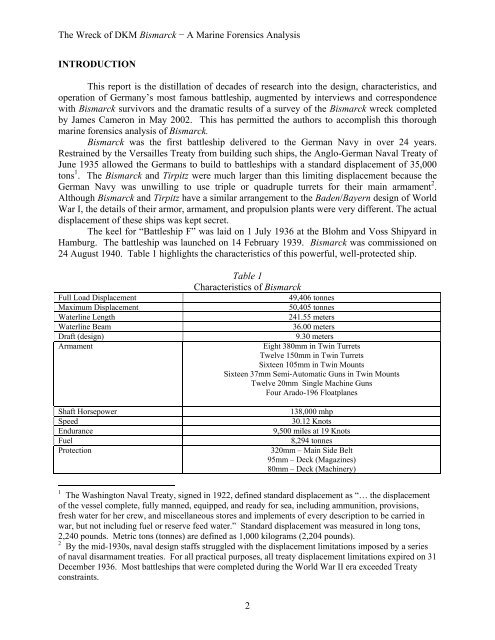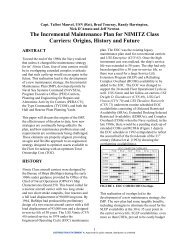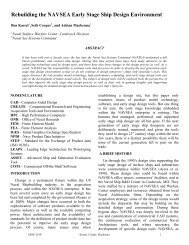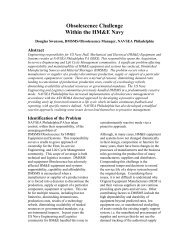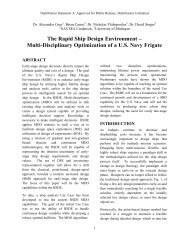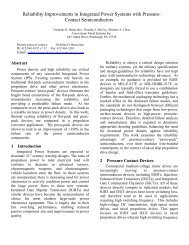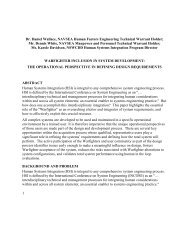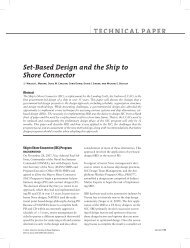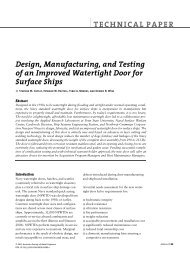The Wreck of DKM Bismarck − A Marine Forensics Analysis 1 The ...
The Wreck of DKM Bismarck − A Marine Forensics Analysis 1 The ...
The Wreck of DKM Bismarck − A Marine Forensics Analysis 1 The ...
You also want an ePaper? Increase the reach of your titles
YUMPU automatically turns print PDFs into web optimized ePapers that Google loves.
<strong>The</strong> <strong>Wreck</strong> <strong>of</strong> <strong>DKM</strong> <strong>Bismarck</strong> <strong>−</strong> A <strong>Marine</strong> <strong>Forensics</strong> <strong>Analysis</strong><br />
INTRODUCTION<br />
This report is the distillation <strong>of</strong> decades <strong>of</strong> research into the design, characteristics, and<br />
operation <strong>of</strong> Germany’s most famous battleship, augmented by interviews and correspondence<br />
with <strong>Bismarck</strong> survivors and the dramatic results <strong>of</strong> a survey <strong>of</strong> the <strong>Bismarck</strong> wreck completed<br />
by James Cameron in May 2002. This has permitted the authors to accomplish this thorough<br />
marine forensics analysis <strong>of</strong> <strong>Bismarck</strong>.<br />
<strong>Bismarck</strong> was the first battleship delivered to the German Navy in over 24 years.<br />
Restrained by the Versailles Treaty from building such ships, the Anglo-German Naval Treaty <strong>of</strong><br />
June 1935 allowed the Germans to build to battleships with a standard displacement <strong>of</strong> 35,000<br />
tons 1 . <strong>The</strong> <strong>Bismarck</strong> and Tirpitz were much larger than this limiting displacement because the<br />
German Navy was unwilling to use triple or quadruple turrets for their main armament 2 .<br />
Although <strong>Bismarck</strong> and Tirpitz have a similar arrangement to the Baden/Bayern design <strong>of</strong> World<br />
War I, the details <strong>of</strong> their armor, armament, and propulsion plants were very different. <strong>The</strong> actual<br />
displacement <strong>of</strong> these ships was kept secret.<br />
<strong>The</strong> keel for “Battleship F” was laid on 1 July 1936 at the Blohm and Voss Shipyard in<br />
Hamburg. <strong>The</strong> battleship was launched on 14 February 1939. <strong>Bismarck</strong> was commissioned on<br />
24 August 1940. Table 1 highlights the characteristics <strong>of</strong> this powerful, well-protected ship.<br />
Table 1<br />
Characteristics <strong>of</strong> <strong>Bismarck</strong><br />
Full Load Displacement 49,406 tonnes<br />
Maximum Displacement 50,405 tonnes<br />
Waterline Length 241.55 meters<br />
Waterline Beam 36.00 meters<br />
Draft (design) 9.30 meters<br />
Armament Eight 380mm in Twin Turrets<br />
Twelve 150mm in Twin Turrets<br />
Sixteen 105mm in Twin Mounts<br />
Sixteen 37mm Semi-Automatic Guns in Twin Mounts<br />
Twelve 20mm Single Machine Guns<br />
Four Arado-196 Floatplanes<br />
Shaft Horsepower 138,000 mhp<br />
Speed 30.12 Knots<br />
Endurance 9,500 miles at 19 Knots<br />
Fuel 8,294 tonnes<br />
Protection 320mm – Main Side Belt<br />
95mm – Deck (Magazines)<br />
80mm – Deck (Machinery)<br />
1 <strong>The</strong> Washington Naval Treaty, signed in 1922, defined standard displacement as “… the displacement<br />
<strong>of</strong> the vessel complete, fully manned, equipped, and ready for sea, including ammunition, provisions,<br />
fresh water for her crew, and miscellaneous stores and implements <strong>of</strong> every description to be carried in<br />
war, but not including fuel or reserve feed water.” Standard displacement was measured in long tons,<br />
2,240 pounds. Metric tons (tonnes) are defined as 1,000 kilograms (2,204 pounds).<br />
2 By the mid-1930s, naval design staffs struggled with the displacement limitations imposed by a series<br />
<strong>of</strong> naval disarmament treaties. For all practical purposes, all treaty displacement limitations expired on 31<br />
December 1936. Most battleships that were completed during the World War II era exceeded Treaty<br />
constraints.<br />
2


